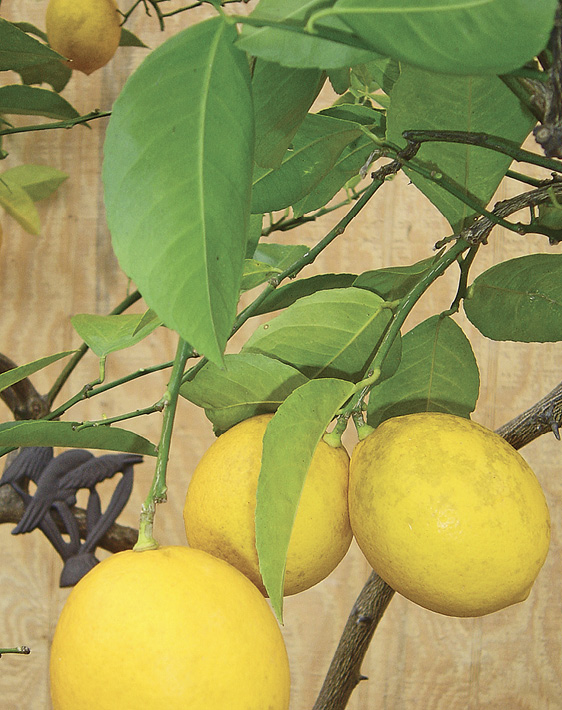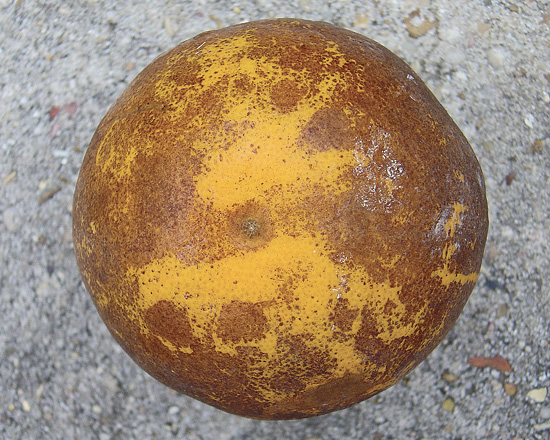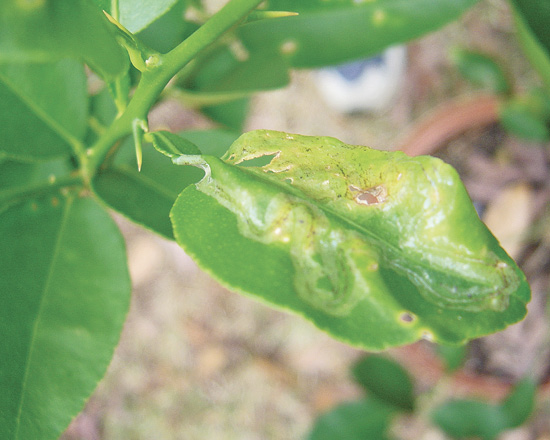Growing Citrus in Containers in Mississippi

Growing citrus in containers is not a new trend. Europeans grew citrus in beautiful and exotic orangeries in the 17th century. The most famous, L’orangerie du château de Versailles, was built for Louis XIV from 1684 to 1686.
In-ground citrus production in Mississippi is generally recommended only in the counties situated along the Gulf Coast. Counties slightly farther north can grow citrus in protected areas, but as you get farther from the coastal regions, outdoor winter protection becomes increasingly more difficult. This means homeowners in most Mississippi counties are restricted to growing citrus in some type of container.
In areas where winter temperatures regularly dip below 25°F, citrus trees need a sunny spot protected from frost and freezing temperatures. Citrus types vary in their tolerance to sub-freezing temperatures.
Citrus trees can lose their leaves because of the cold and still survive. Listed below are the different citrus types based on relative cold hardiness ranked from more hardy to more tender.
- Kumquat
- Calamondin
- Satsuma
- Sweet Orange
- Navel Orange
- Mandarin
- Grapefruit
- Tangerine
- Tangelo
- Lemon
- Lime
The kumquat, calamondin, and satsuma have the greatest degree of cold hardiness. When they are properly hardened, bearing trees withstand temperatures as low as 18–20°F without much wood damage. Tangerines and mandarins usually withstand temperatures as low as the low 20s before significant wood damage occurs. Sweet orange and grapefruit are somewhat less cold hardy and usually show severe damage at temperatures in the low- to mid-20s. Lemon and lime trees are easily killed or severely damaged by freezing temperatures from the mid- to high-20s.
Remember that on a cold, clear night with little or no wind movement, leaf temperature can easily drop three to four degrees below air temperature because of radiation heat loss. This can defoliate, damage, and possibly kill small branches.
Citrus fruit easily freezes at 26–28°F when these temperatures last for several hours.
We recommend that you cover or move container-grown citrus into protected areas when the weather forecast is for temperatures of 28°F or below. If a prolonged cold spell is forecast, the container needs to be in a fully enclosed area or heated with a lightbulb.
Recommended Citrus Varieties
Any type of citrus tree can be grown in a container. But navel oranges, grapefruit, and most other oranges are very vigorous and outgrow all but very large containers. Also, some exotic crosses are cold tolerant, but availability and eating quality have hurt their spread in the industry.
Naturally small citrus varieties such as ‘Improved Meyer’ lemon, satsumas, kumquats, and calamodins are easy to grow in containers. If you can purchase citrus that is grafted onto ‘Flying Dragon’ rootstock, it will be significantly dwarfed. That extends its life in a container.
Many varieties of citrus are available by mail order. The less cold-hardy varieties need more care. The citrus available in local retail centers are usually cold-tolerant varieties. Plants grafted onto ‘trifoliate orange’ rootstock have more cold tolerance because of the hardiness of the rootstock.
Satsuma, kumquat, and lemon are types of citrus commonly grown by South Mississippi homeowners. These citrus types have a good degree of cold tolerance and a long history of being grown in the soil in South Mississippi. Their smaller size and relative cold-tolerance make them good candidates for container culture. Following are some recommended varieties:
‘Owari’ satsuma was introduced from Japan and is the most widely available satsuma. The fruit is seedless and matures from October to mid-November. ‘Owari’ trees tend to be more vigorous than other satsumas.
‘Brown’s Select’ satsuma produces medium to large fruit. The fruit matures from mid-October to early November, one to two weeks ahead of ‘Owari’ satsuma. ‘Brown’s Select’ is slightly more cold hardy than ‘Owari’. The fruit is medium sized, bright orange, and often has a slightly bumpy rind. Fruit is often ready to eat when the rind is still green.
‘Kimbrough’ satsuma was released from Louisiana as a cold-hardy satsuma after surviving a hard freeze. Unfortunately, its cold-hardiness is no better than that of ‘Owari.’ The trees of ‘Kimbrough’ are large, strong, spreading, and very productive. Its fruit is generally larger than ‘Owari’ and matures in early to mid-November.
‘LA Early’ and ‘Early St. Ann’ produce medium to large fruit that mature from early September through mid-October. Both varieties produce better than ‘Early Armstrong’ and have better fruit quality. However, the fruit does not hold well on the tree for an extended period. These varieties are a good complement to varieties that mature later in the season.
‘Nagami’ kumquats produce oblong fruit with a smooth rind, deep orange color, and acid juice. They ripen from mid-October through February. The fruit is one and a half to two inches long and one to two inches in diameter and contains seeds. The ‘Nagami’ tree is vigorous, with a round, bushy top. It is very cold hardy.
‘Meiwa’ kumquats have round fruit, one and a half to two inches in size with sweet pulp. The trees are less vigorous than ‘Nagami’ but are very cold hardy.
‘Improved Meyer’ is the only lemon recommended for planting in containers since it does have a small degree of cold hardiness. It is not a true lemon but is a cross between a true lemon and an orange. It ripens in mid-October and holds on the tree until December or longer. ‘Meyer’ is better when grown from a rooted cutting than when grafted. It has a strong tendency to bloom and set fruit throughout the year.
Container Type and Size
Another choice you have to make is the type and size of container you will use to grow the citrus. In traditional European orangeries, the classic container was a 24-inch square, deep, wooden container painted white. Half whiskey barrels are a good size and are somewhat decorative. But wooden containers may be prone to decay. You can significantly slow the decay process by treating the container with a wood preservative or by building boxes out of treated lumber. The downside to wooden containers is that they can be quite heavy, especially when you get into the larger sizes.
Plastic nursery containers or decorative pots are good choices because they are lightweight. Citrus trees are normally sold in two- to three-gallon nursery containers. Almost all need to be moved up to a larger container within a year of purchase. Every three to five years you will need a larger container, depending on the vigor of the variety of citrus you are growing. Eventually you might need a pot about the size of a 15-gallon nursery container.
You can fit larger-sized containers with wheels to make them mobile, or you can move them with a hand-truck. Citrus trees do not like wet feet, so whatever kind of container you use, make sure it has good drainage. If the container does not have drainage, cut holes in the sides near the bottom, and raise it slightly off the ground.
Growing Media
Do not use ordinary garden soil for container citrus, no matter how good it is for growing plants in the ground. Buy a premixed potting soil designed for container plants. Diseases and weeds may be introduced if you use common garden soil. Soil also makes the container very heavy when it is wet.
You can make your own soil mix, but unless you need a lot, it is cheaper to buy it ready-made. A good mixture is four to five parts ground pine bark and one part sand. If you want a mixture that holds a little more water, substitute one part peat moss for one part sand.
Do not plant the tree too deeply in the container. You should be able to see the root flare on the plant trunk at the surface of the growing medium. Keep the growing medium off of the trunk to prevent decay.
Watering and Fertilizing
Citrus plants in containers require more frequent watering than plants growing in soil. During hot, dry weather, you probably need to water daily. Before watering, see if there is moisture below the top inch or two of soil, not just a dry surface. Do not allow the root ball to get dry! This causes the root ball to pull away from the edges of the container and makes rewetting very difficult.
Frequent watering flushes out required nutrients much faster than when plants are grown in soil. To prevent potential nutrient deficiencies, we recommend a slow-release fertilizer. Even with these, several applications are required during the growing season, depending on their release rate. Slow-release fertilizer formulations of 12-6-6 or 12-4-6 are usually available locally. You can buy specialized citrus fertilizers online.
Citrus trees are prone to deficiencies of the micronutrients iron, manganese, and zinc. Select slow-release fertilizers that contain these important micronutrients. Another option is to purchase and apply the micronutrients separately.
Container Location
Citrus trees need eight or more hours of direct sunlight or “gro-lights” per day to grow properly. Sunny, wind-free locations with southern exposure are best. Find a warm microclimate in a corner of your house where the tree receives reflected heat from walls. In extended periods of cold winter weather, all types of citrus need to be indoors.
Insect Problems
Container-grown citrus can attract several insect pests. These pests become an even bigger problem when you bring the containers indoors for cold weather protection.
While containers are outdoors they can become a haven for ants. Ants are attracted to aphids and scale insects that attack the citrus. To reduce this problem, control the aphids and scale insects and/or use ant baits or sprays around the outside of the container.
Spider mites commonly infest citrus. They give the leaves a washed-out appearance. If fruit are present, mite feeding scars them and gives the fruit a brown appearance.
Citrus rust mites feeding on the fruit surface cause surface blemishes that can reduce fruit size and increase fruit drop. When a fruit is injured in summer or fall, the injured surface is smooth and dark brown. This is known as “bronzing.” Rust mite feeding on fruit early in the spring injures the peel, which is somewhat rough in texture but lighter in color and is referred to as “sharkskin.”

If you find harmful insects such as scales, aphids, or mites, a household spray bottle of water with some mild dish soap (11 tsp/gallon water) could be all you need. If insects persist, the usual nursery treatment is a 1 percent solution of light horticultural oil.
A relatively new insect, citrus leafminer, is showing up in citrus trees. Citrus leafminer larvae form mines predominantly in leaves but also in succulent stems and sometimes fruit. The larvae tunnel through the leaf epidermis, ingest the sap, and produce a chlorotic leaf patch. Citrus leafminers usually prevent young leaves from expanding, causing them to remain twisted and curled. Home gardeners can get excellent control of citrus leafminers by using spinosad insecticide.

Occasionally citrus trees become infested with the orange-dog caterpillar, which is the larval form of the Giant Swallowtail butterfly. The caterpillars are a problem only on young trees, since one or two can completely strip a young tree of its foliage.
Diseases
Citrus trees grown in containers do not generally suffer from as many diseases as those grown in the ground. Root rots tend to be the worst problems if you use a poorly drained medium.
Sooty mold fungus is not a parasitic organism but can be a problem on plants infested with white flies, aphids, mealy bugs, or scale insects. The black mold grows in the honeydew these insects secrete. Sooty mold can cause damage by reducing photosynthesis in the leaves and by making the fruit black and unattractive. Fruit covered with sooty mold does not develop color properly.
Summary
Mississippi gardeners can produce a limited amount of high- quality citrus products by growing them in containers anywhere in the state. There are some challenges to this type of production, but the effort is worthwhile.
The information given here is for educational purposes only. References to commercial products, trade names, or suppliers are made with the understanding that no endorsement is implied and that no discrimination against other products or suppliers is intended.
Publication 2542 (POD-05-22)
Reviewed by Christine Coker, PhD, Extension/Research Professor, Coastal Research and Extension Center. Written by Wayne Porter, PhD, former Regional Extension Specialist, Horticulture.
The Mississippi State University Extension Service is working to ensure all web content is accessible to all users. If you need assistance accessing any of our content, please email the webteam or call 662-325-2262.








